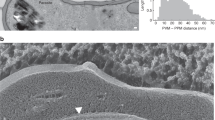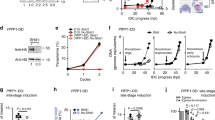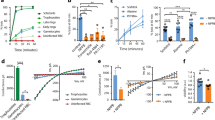Abstract
As the malaria parasite, Plasmodium falciparum, grows within its host erythrocyte it induces an increase in the permeability of the erythrocyte membrane to a range of low-molecular-mass solutes, including Na+ and K+ (ref. 1). This results in a progressive increase in the concentration of Na+ in the erythrocyte cytosol2,3. The parasite cytosol has a relatively low Na+ concentration2,4 and there is therefore a large inward Na+ gradient across the parasite plasma membrane. Here we show that the parasite exploits the Na+ electrochemical gradient to energize the uptake of inorganic phosphate (Pi), an essential nutrient. Pi was taken up into the intracellular parasite by a Na+-dependent transporter, with a stoichiometry of 2Na+:1Pi and with an apparent preference for the monovalent over the divalent form of Pi. A Pi transporter (PfPiT) belonging to the PiT family was cloned from the parasite and localized to the parasite surface. Expression of PfPiT in Xenopus oocytes resulted in Na+-dependent Pi uptake with characteristics similar to those observed for Pi uptake in the parasite. This study provides new insight into the significance of the malaria-parasite-induced alteration of the ionic composition of its host cell.
This is a preview of subscription content, access via your institution
Access options
Subscribe to this journal
Receive 51 print issues and online access
$199.00 per year
only $3.90 per issue
Buy this article
- Purchase on Springer Link
- Instant access to full article PDF
Prices may be subject to local taxes which are calculated during checkout



Similar content being viewed by others
References
Kirk, K. Membrane transport in the malaria-infected erythrocyte. Physiol. Rev. 81, 495–537 (2001)
Lee, P., Ye, Z., Van Dyke, K. & Kirk, R. G. X-ray microanalysis of Plasmodium falciparum and infected red blood cells: effects of qinghaosu and chloroquine on potassium, sodium, and phosphorus composition. Am. J. Trop. Med. Hyg. 39, 157–165 (1988)
Staines, H. M., Ellory, J. C. & Kirk, K. Perturbation of the pump-leak balance for Na+ and K+ in malaria-infected erythrocytes. Am. J. Physiol. Cell Physiol. 280, C1576–C1587 (2001)
Wunsch, S. et al. Differential stimulation of the Na+/H+ exchanger determines chloroquine uptake in Plasmodium falciparum. J. Cell Biol. 140, 335–345 (1998)
Saliba, K. J., Horner, H. A. & Kirk, K. Transport and metabolism of the essential vitamin pantothenic acid in human erythrocytes infected with the malaria parasite Plasmodium falciparum. J. Biol. Chem. 273, 10190–10195 (1998)
Turner, R. J. Stoichiometry of cotransport systems. Ann. NY Acad. Sci. 456, 10–25 (1985)
Kumler, W. D. & Eiler, J. J. The acid strength of mono and diesters of phosphoric acid. The n-alkyl esters from methyl to butyl, the esters of biological importance, and the natural guanidine phosphoric acids. J. Am. Chem. Soc. 65, 2355–2361 (1943)
Allen, R. J. W. & Kirk, K. The membrane potential of the intraerythrocytic malaria parasite Plasmodium falciparum. J. Biol. Chem. 279, 11264–11272 (2004)
Martin, R. E., Henry, R. I., Abbey, J. L., Clements, J. D. & Kirk, K. The ‘permeome’ of the malaria parasite: an overview of the membrane transport proteins of Plasmodium falciparum. Genome Biol. 6, R26 (2005)
Gardner, M. J. et al. Genome sequence of the human malaria parasite Plasmodium falciparum. Nature 419, 498–511 (2002)
Salaun, C., Rodrigues, P. & Heard, J. M. Transmembrane topology of PiT-2, a phosphate transporter-retrovirus receptor. J. Virol. 75, 5584–5592 (2001)
Le Roch, K. G. et al. Discovery of gene function by expression profiling of the malaria parasite life cycle. Science 301, 1503–1508 (2003)
Bozdech, Z. et al. The transcriptome of the intraerythrocytic developmental cycle of Plasmodium falciparum. PLoS Biol. 1, E5 (2003)
Rager, N., Mamoun, C. B., Carter, N. S., Goldberg, D. E. & Ullman, B. Localization of the Plasmodium falciparum PfNT1 nucleoside transporter to the parasite plasma membrane. J. Biol. Chem. 276, 41095–41099 (2001)
Kavanaugh, M. P. et al. Cell-surface receptors for gibbon ape leukemia virus and amphotropic murine retrovirus are inducible sodium-dependent phosphate symporters. Proc. Natl Acad. Sci. USA 91, 7071–7075 (1994)
Bai, L., Collins, J. F. & Ghishan, F. K. Cloning and characterization of a type III Na-dependent phosphate cotransporter from mouse intestine. Am. J. Physiol. 279, C1135–C1143 (2000)
Dubyak, G. R. Ion homeostasis, channels, and transporters: an update on cellular mechanisms. Adv. Physiol. Educ. 28, 143–154 (2004)
Opekarova, M. & Tanner, W. Specific lipid requirements of membrane proteins—a putative bottleneck in heterologous expression. Biochim. Biophys. Acta 1610, 11–22 (2003)
Bröer, A. et al. Molecular cloning of mouse amino acid transport system B0, a neutral amino acid transporter related to Hartnup disorder. J. Biol. Chem. 279, 24467–24476 (2004)
Bröer, S. et al. Comparison of lactate transport in astroglial cells and monocarboxylate transporter 1 (MCT 1) expressing Xenopus laevis oocytes. Expression of two different monocarboxylate transporters in astroglial cells and neurons. J. Biol. Chem. 272, 30096–30102 (1997)
Bröer, S. Xenopus laevis oocytes. Methods Mol. Biol. 227, 245–258 (2003)
Mullin, K. A. et al. Membrane transporters in the relict plastid of malaria parasites. Proc. Natl Acad. Sci. USA 103, 9572–9577 (2006)
Acknowledgements
We thank the Australian Red Cross Blood Service (Canberra and Melbourne) for the provision of blood. This work was supported by grants from the Australian National Health and Medical Research Council (NHMRC), the Australian Research Council (ARC), the Howard Hughes Medical Institute and the ARC/NHMRC Network for Parasitology. Author Contributions S.B. and K.K. contributed equally to this work and are joint senior authors.
Author information
Authors and Affiliations
Corresponding author
Ethics declarations
Competing interests
Reprints and permissions information is available at www.nature.com/reprints. The authors declare no competing financial interests.
Supplementary information
Supplementary Notes
This file contains Supplementary Figures 1–5, Supplementary Methods and additional references. (PDF 1931 kb)
Rights and permissions
About this article
Cite this article
Saliba, K., Martin, R., Bröer, A. et al. Sodium-dependent uptake of inorganic phosphate by the intracellular malaria parasite. Nature 443, 582–585 (2006). https://doi.org/10.1038/nature05149
Received:
Accepted:
Published:
Issue Date:
DOI: https://doi.org/10.1038/nature05149
This article is cited by
-
Metabolic responses in blood-stage malaria parasites associated with increased and decreased sensitivity to PfATP4 inhibitors
Malaria Journal (2023)
-
Metabolic adjustments of blood-stage Plasmodium falciparum in response to sublethal pyrazoleamide exposure
Scientific Reports (2022)
-
Comparison of 15 dinoflagellate genomes reveals extensive sequence and structural divergence in family Symbiodiniaceae and genus Symbiodinium
BMC Biology (2021)
-
Acanthamoeba castellanii phosphate transporter (AcPHS) is important to maintain inorganic phosphate influx and is related to trophozoite metabolic processes
Journal of Bioenergetics and Biomembranes (2020)
-
Physiological regulation of phosphate by vitamin D, parathyroid hormone (PTH) and phosphate (Pi)
Pflügers Archiv - European Journal of Physiology (2019)
Comments
By submitting a comment you agree to abide by our Terms and Community Guidelines. If you find something abusive or that does not comply with our terms or guidelines please flag it as inappropriate.



